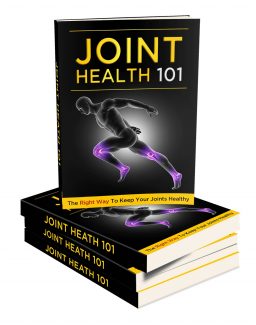 License Type: Master Resell Rights
License Type: Master Resell Rights  File Type: ZIP
File Type: ZIP
 SKU: 62579
SKU: 62579  Shipping: Online Download
Shipping: Online Download
Sample Content Preview
Introduction
If you’ve ever sat in awe watching children play, marvelling at the immense amount of energy and flexibility they have, you know that it’s thanks to their healthy joints. But as you age, even bending down to pick something up from the floor can become an impossible feat.
So how do you deal with this?
While you can’t really fight the process of aging, you can surely slow down the rate of damage inflicted on joints due to wear and tear. Learning how to nourish and take care of your joints will let you stay flexible for longer and yield relief for painful joints.
Read on to see what it takes to keep yourself and your joints moving well even in old age.
Chapter 1
The Importance of Joint Health
Every time you sprint to catch the bus, score a point against your opposing team, or shoot pool with friends, you’re using your extremely functional musculoskeletal system. This means a combination of bones, joints and muscles get you going where you want to go.
But muscles and bones don’t work alone. Instead there are joints that link these together. While bones support your body’s entire weight, your muscles pull your bones as you move. Joints are the connecting links that put both bones and muscles in motion.
Given the important functions of mobility and movement, it becomes crucial that you take good care of your joints. After all, you put them through so much wear and tear throughout your life.
Joints that aren’t well taken care of become susceptible to injury, inflammation and general dislocation. As age catches up with you, you can feel the effects of overuse weathering away your joints. So keep your joints healthy at every stage of your life so they can keep you moving even in old age.
But before we look at ways to do so, here’s a quick look at the anatomy of a joint so you can better understand what goes into keeping your joints healthy. Page | 10
What Are Joints?
Imagine if the skeleton had only one solid bone. That would make it very difficult to move. So instead nature solved this problem by dividing the skeleton into many bones, and creating joints where the bones intersect.
Joints are also known as articulations forming strong connections that join bones, teeth, and cartilage to one another. Now you have the freedom of movement in different ways and directions.
Some joints open and close like a hinge such as your knees and elbows, allowing you to straighten or bend your legs and arms. You sit down, stand up, pick up, and put down stuff using these joints without giving it a second thought.
Others joints are meant for more complicated movements such as your shoulder or hip joint. These allow for forward, backward, sideways, and rotating movements. Just think of everything you can do with these joints and you’ll get an idea of how limited your movement can become if any of these joints suffer damage.
But not all joints are created equal. For instance, while joints like the knees provide stability, others like the wrist, ankles, and hips let you move, glide, skip, or run.
And just as their functions vary, so does their anatomy. Which means that you also need to take care of them in specific ways.
Some joints are purely made of tough collagen fiber while others have cartilage binding bones together. Yet others have something known as synovial fluid in between cartilage pads at the end of articulating bones.
So while you may think that all joints can be maintained using the same methods, you may need to rethink your joint-health strategy. Let’s first take a look at the different types of joints found in the body before discussing how to take care of them.
Types of Joints And Their Functions
Each joint is specialized in its shape and structure to control the range of motion between the parts it connects.
For easier understanding, you may classify joints based on the function they perform or how much movement they allow. You can also do the same based on the structure of the joint, or the material that is present in the joint. This means looking at how the bones are attached to one another.
Both categories will let you divide joints into three broad classes:
Immovable or fixed joints. These are typically fibrous joints that are held together by dense fibrous connective tissue. Think about the bony plates of the skull to get an idea. There are links or joints between the edges of these plates made of fibrous tissue. The point is to make them immovable to protect the brain.








